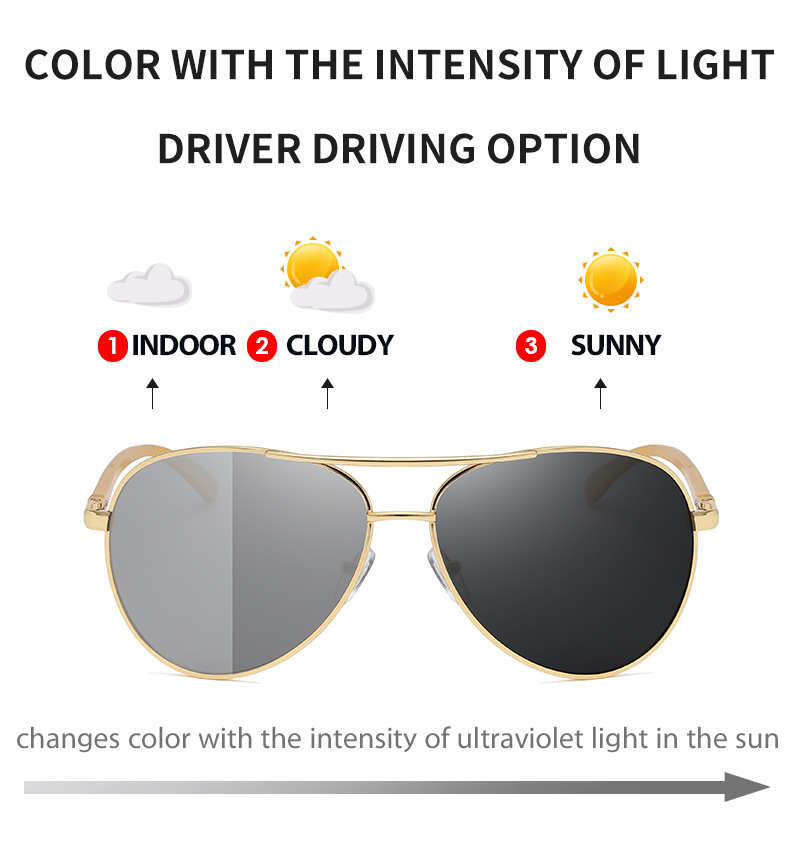Summer is here, the hours of sunshine are getting longer and the sun is getting stronger. Walking on the street, it is not difficult to find that more people wear photochromic lenses than before. Myopia sunglasses are the rising revenue growth point of the eyewear retail industry in recent years, and photochromic lenses are the guarantee of enduring summer sales. The acceptance of photochromic lenses by the market and consumers comes from various needs such as styling, light protection and driving.
Nowadays, more and more people are aware of the damage of ultraviolet rays to the skin. Sunscreen, parasols, peaked caps, and even ice silk sleeves have become must-haves for going out in summer. The damage of ultraviolet rays to the eyes may not be as immediate as the skin being tanned, but in the long run, too much direct exposure may have more serious consequences on the eyes.
THE PRINCIPLE OF COLOR CHANGE: PHOTOCHROMISM
The color of the photochromic lens becomes darker outdoors, reaching a state similar to that of sunglasses, and the feature of returning to the indoor colorless and transparent is related to the concept of “photochromic”, which is related to a substance called silver halide. During the production process, lens manufacturers add silver halide microcrystalline particles to the substrate or film layer of the lens. When the strong light is irradiated, the silver halide decomposes into silver ions and halide ions, absorbing most of the ultraviolet light and part of the visible light; when the ambient light becomes dark, the silver ions and halide ions regenerate silver halide under the reduction of copper oxide, and the color of the lens becomes lighter until it returns to colorless and transparent.
The color change of photochromic lenses is actually caused by a series of reversible chemical reactions. Light (including visible light and ultraviolet light) also plays an important role in the reaction. Naturally, it is also affected by seasons and weather, and does not always maintain a stable and consistent color change effect.
Generally speaking, in sunny weather, the ultraviolet rays are stronger, and the photochromic reaction is stronger, and the depth of lens discoloration is generally deeper. On cloudy days, the ultraviolet rays are weaker, and the illumination is not strong, and the color of the lens will be lighter. In addition, as the temperature rises, the color of the photochromic lens will gradually become lighter; conversely, when the temperature decreases, the color of the photochromic lens will gradually become darker. This is because when the temperature is high, the decomposed silver ions and halide ions will be reduced again under the action of high energy to form silver halide, and the color of the lens will become lighter.
Regarding photochromic lenses, there are the following common questions and knowledge points:
1. WILL PHOTOCHROMIC LENSES HAVE WORSE LIGHT TRANSMISSION/CLARITY THAN REGULAR LENSES?
The photochromic lenses of high-quality photochromic technology are completely without background color, and the light transmittance will not be worse than that of ordinary lenses.
2. WHY DO PHOTOCHROMIC LENSES NOT CHANGE COLOR?
The change of color of photochromic lenses is related to two factors, one is light conditions, and the other is the color change factor (silver halide). If it does not change color under strong light and ultraviolet light, it is probably because its color changing factor has been destroyed.
3. WILL THE DISCOLORATION EFFECT OF PHOTOCHROMIC LENSES BECOME WORSE DUE TO PROLONGED USE?
Like any ordinary lens, photochromic lenses also have a lifespan. If you pay attention to maintenance, the use time will generally reach more than 2 to 3 years.
4. WHY DO PHOTOCHROMIC LENSES TEND TO DARKEN AFTER WEARING THEM FOR A LONG TIME?
Photochromic lenses are dark in color after being worn for a long time, and cannot be completely turned back to transparent because the color-changing factors in them cannot return to their original state after discoloration, resulting in a background color. This phenomenon often occurs in poor-quality photochromic lenses, but it will not occur in good photochromic lenses.
5. WHY ARE GRAYED LENSES THE MOST COMMON ON THE MARKET?
Gray lenses absorb IR and 98% of UV rays. The biggest advantage of the gray lens is that it will not change the original color of the scene due to the lens, effectively reducing the light intensity. Gray lenses can absorb any color spectrum evenly, so the viewing scene will only become darker, but there will be no obvious chromatic aberration, showing a true and natural feeling. In addition, gray is a neutral color, suitable for all groups of people, and more popular in the market.
If you want to know more about glasses fashion trends and industry consultation, please visit our website and contact us anytime.
Post time: Jul-25-2023









